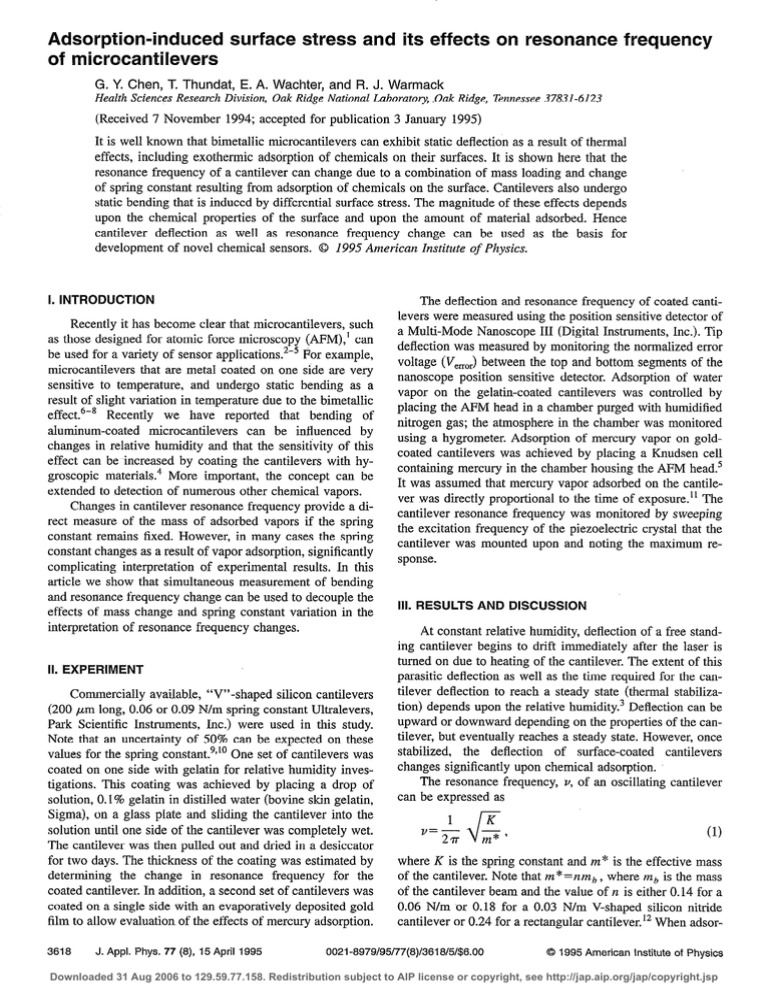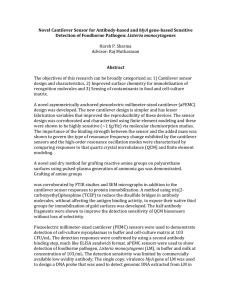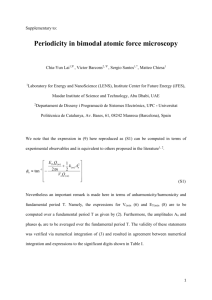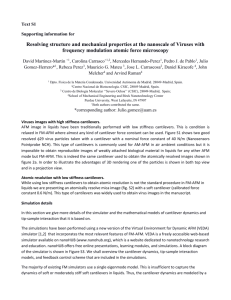Adsorption-induced surface stress and its effects ... of microcantilevers
advertisement

Adsorption-induced of microcantilevers surface stress and its effects on resonance frequency G. Y. Chen, T. Thundat, E. A. Wachter, and R. J. Warmack Health SciencesResearchDivision, Oak Ridge National Laboratory, Oak Ridge, Tennessee37831-hI23 (Received 7 November 1994; accepted for publication 3 January 1995) It is well known that bimetallic microcantilevers can exhibit static deflection as a result of thermal effects, including exothermic adsorption of chemicals on their surfaces. It is shown here that the resonance frequency of a cantilever can change due to a combination of mass loading and change of spring constant resulting from adsorption of chemicals on the surface. Cantilevers also undergo static bending that is induced by differential surface stress. The magnitude of these effects depends upon the chemical properties of the surface and upon the amount of material adsorbed. Hence cantilever deflection as well as resonance frequency change can be used as the basis for development of novel chemical sensors. 0 1995 American Institute of Physics. I. INTRODUCTION Recently it has become clear that microcantilevers, such as those designed for atomic force microscopy @FM),’ can be used for a variety of sensor applications.‘-5 For example, microcantilevers that are metal coated on one side are very sensitive to temperature, and undergo static bending as a result of slight variation in temperature due to the bimetallic effect.“-* Recently we have reported that bending of aluminum-coated microcantilevers can be influenced by changes in relative humidity and that the sensitivity of this effect can be increased by coating the cantilevers with hygroscopic materials.4 More important, the concept can be extended to detection of numerous other chemical vapors. Changes in cantilever resonance frequency provide a direct measure of the mass of adsorbed vapors if the spring constant remains fixed. However, in many cases the spring constant changes as a result of vapor adsorption, significantly complicating interpretation of experimental results. In this article we show that simultaneous measurement of bending and resonance frequency change can be used to decouple the effects of mass change and spring constant variation in the interpretation of resonance frequency changes. II. EXPERIMENT Commercially available, “Y-shaped silicon cantilevers (200 pm long, 0.06 or 0.09 N/m spring constant Ultralevers, Park Scientific Instruments, inc.) were used in this study. Note that an uncertainty of 50% can be expected on these values for the spring constantg*tO One set of cantilevers was coated on one side with gelatin for relative humidity investigations. This coating was achieved by placing a drop of solution, 0.1% gelatin in distilled water (bovine skin gelatin, Sigma), on a glass plate and sliding the cantilever into the solution until one side of the cantilever was completely wet. The cantilever was then pulled out and dried in a desiccator for two days. The thickness of the coating was estimated by determining the change in resonance frequency for the coated cantilever. In addition, a second set of cantilevers was coated on a single side with an evaporatively deposited gold film to allow evaluation of the effects of mercury adsorption. 3618 J. Appl. Phys. 77 (8), 15 April 1995 The deflection and resonance frequency of coated cantilevers were measured using the position sensitive detector of a Multi-Mode Nanoscope III (Digital Instruments, Inc.). Tip deflection was measured by monitoring the normalized error voltage (V,,,,) between the top and bottom segments of the nanoscope position sensitive detector. Adsorption of water vapor on the gelatin-coated cantilevers was controlled by placing the APM head in a chamber purged with humidified nitrogen gas; the atmosphere in the chamber was monitored using a hygrometer. Adsorption of mercury vapor on goldcoated cantilevers was achieved by placing a Knudsen cell containing mercury in the chamber housing the AIM head.5 It was assumed that mercury vapor adsorbed on the cantilever was directly proportional to the time of exposure.” The cantilever resonance frequency was monitored by sweeping the excitation frequency of the piezoelectric crystal that the cantilever was mounted upon and noting the maximum response. Ill. RESULTS AND DISCUSSION At constant relative humidity, deflection of a free standing cantilever begins to drift immediately after the laser is turned on due to heating of the cantilever. The extent of this parasitic deflection as well as the time required for the cantilever deflection to reach a steady state (thermal stabilization) depends upon the relative humidity.3 Deflection can be upward or downward depending on the properties of the cantilever, but eventually reaches a steady state. However, once stabilized, the deflection of surface-coated cantilevers changes significantly upon chemical adsorption. The resonance frequency, v, of an oscillating cantilever can be expressed as 1 v=G K m*’ J (1) where K is the spring constant and m” is the effective mass of the cantilever. Note that m*=izmb , where mb is the mass of the cantilever beam and the value of y1is either 0.14 for a 0.06 N/m or 0.18 for a 0.03 N/m V-shaped silicon nitride cantilever or 0.24 for a rectangular cantilever.” When adsor- 0021-8979/95/77(8)/3618J5l$6.00 @ 1995 American Institute of Physics Downloaded 31 Aug 2006 to 129.59.77.158. Redistribution subject to AIP license or copyright, see http://jap.aip.org/jap/copyright.jsp 27.00 R g 10 I- 26.94 E s 5s 8 z 26.88 2 LL 8 8 26.82 8 s' 0 5 0 0 -5 8 8 -10 1 -15 ' I%! 26.-/s, 60 Relative Humidity (4 0 i I 0 I 1 I 2 I 3 Time (minutes) (%) 10 E FIG. 2. Typical plot of error voltage as a function of mercury vapor exposure time for a gold-coated silicon nitride cantilever. Uniform 40-nm-thick layer of gold deposited on one side along entire length of cantilever. The nominal initial K value of the cantilever was 0.06 N/m. 5 80 8 $ t w -5 -10 @I 20 I I 30 40 50 60 70 Relative Humidity (%) FIG. 1. (a) Resonance frequency response for a gelatin-coated silicon cantilever as a function of relative humidity. (b) Bending (error voltage) under same conditions. The nominal K value of the cantilever was 0.06 N/m before gelatin modification. The gelatin film thickness for the cantilever was calculated to be about 23 nm. bates are deposited uniformly on the cantilever surface, the resuhant mass change, &I, can be calculated from K 1 1 &?z= $$qT-Ty (2) i 1 Z’2i where vt and ua are the resonance frequencies before and after adsorption, respectively. This interpretation of frequencies shift assumes that changes in spring constant, SK, are negligible. However, from Eq. (1) it is clear that changes in resonance frequency can result from both mass change or variation in K. In some cases it might also be possible that changes in adsorbed mass could exactly balance changes in K, resulting in negligible change in resonance frequency. To evaluate these possible effects, we will start with an examination of the behavior of gelatin-coated silicon cantilevers upon adsorption of water vapor. A similar study of the effects of mercury vapor adsorption onto gold-coated silicon nitride cantilevers is also presented. Figure l(a) shows the variation in resonance frequency of a gelatin-coated cantilever due to exposure to water vapor, while Fig. l(b) shows the deflection as a function of relative humidity during the same exposure. Note that both cantilever bending and resonance frequency vary almost Linearly with adsorption of moisture. The slope of the bending as well as J. Appl. Phys., Vol. 77, No. 8, 15 April 1995 frequency response was found to depend on the thickness of the gelatin film. The increase in resonance frequency as humidity is increased is counter to that anticipated due to mass loading, suggesting that a change in spring constant is also occurring. The nearly linear response in Figs. l(a) and l(b) indicates that the magnitude of Sm and SK are small relative to the initial values. Similar behavior is observed for gold-coated cantilevers upon exposure to mercury vapor. The bending change is very sensitive to mercury vapor adsorption (Fig. 2), with the error voltage rapidly reaching the limit for the optical detection scheme and restricting the effective range of measurement. The resonance frequency increases rapidly and then reaches a plateau due to mercury vapor adsorption. The increases of resonance frequency (Fig. 3) as exposure progresses must be due to increasing spring constant. From these and other similar experiments it is clear that when molecules adsorb on a cantilever surface, the resonance frequency of the cantilever changes due to mass loading. In addition to resonance frequency change, deflection [bending) may change due to adsorption-induced differential surface stress, B. This differential surface stress (& = s, - sa, where s t and s2 are the induced stresses on the top and bottom surface of the cantilever) can be large if the adsorption on one face of the cantilever is different from the other, resulting in measurable bending. For the case of an elastically bent rectangular cantilever, the bending moment is M = ss Wt/2,‘3J4 where W is the width and t is the thickness of the cantilever. When the length of the cantilever is much larger than the width, Hooke’s Law for small displacements relating the curvature with effective modulus, Y, and moment, M, is given by d2z M &-TTTaking into account the biaxial plane strain conditions associated with thin films and the film-substrate interface, the Chen et al. 3619 Downloaded 31 Aug 2006 to 129.59.77.158. Redistribution subject to AIP license or copyright, see http://jap.aip.org/jap/copyright.jsp 18.05 Ti 5 V 18.00 g 17.95 !i B 2 17.90 Top View Side View 17.85 17.80 0 1 2 3 4 5 6 7 Time (minutes) FIG. 3. Resonance frequency response as a function of mercury exposure recorded simultaneously with error voltage shown in Fig. 2. The theoretical curve (solid line) was calculated using Eq. (6) The initial deviation of the experimental data from theoretical response may be due to time required for the mercury vapor to reach equilibrium. The mass of the cantilever, nb , is 34.6 ng. Mercury vapor adsorption rate and the rate at which K varies are calculated to be 553 pg/min and 0.001 N/m/m& respectively. effective modulus Y in isotropic elasticity, is El( 1 - u),14-16 where u is Poisson’s ratio and E is the Young’s modulus for the substrate. For rectangular cantilevers, the area moment of inertia I is given by Wt3/12.17 When substituted into Eq. (3) this becomes Stoney’s formula’3~‘4~‘s~1g FIG. 4. Schematic diagram of a V-shaped cantilever used in model. where the initial resonance frequency v1 changes to v, due to adsorption. In this equation K changes to R+ SK as a result of adsorption-induced surface stress while m* changes to m* fn 6m due to mass loading. The surface stress also generates a radial forceI =(sl-bs?)L. I -= R 6(1-u)& Et2 (4) ’ where the reciprocal of the radius of curvature, R, equals d”zldy2. However, boundary conditions determine the solution of Eq. (3). In Eq. (4), R is constant and is independent of lateral shape, size, and the method of holding the cantilever. Taking into account the boundary conditions of a cantilever, Eq. (3) can be solved and the displacement of the cantilever, ;: can be written as z= (W;;jL2) &, where L is the length of the cantilever. For triangular cantilevers such as those used in this study (Fig. 4), the crosssectional width varies along the length. Standard parameters for commercial cantilevers are given in Refs. 12 and 20. For OGyGL, , the moment of the inertia, I= Wt3/6, and the moment, M= W&t, while for L,<GL, I= [(l -ylL)Bt3/12] and M= [B( 1 -y/L) &t/2]. The bending of the end of a triangular cantilever is given by EC& (5j, and can be measured very sensitively. For the data shown in Fig. l(b), a value of 0.38 N/m can be calculated for the differential surface stress, c%, using Eq. (5). Surface stress can also affect the spring constant of the cantilever. To account for this, Eq. (1) can be modified as %=G v==- m*+n/Jm 3620 ’ J. Appl. Phys., Vol. 77, No. 8, 15 April 1995 (6) (7) This force is equivalent to a radial force applied on the median plane m of the lever (Fig. 4), which favors contraction or expansion of the lever according to the sign of (s 1+ sJ. Since the cantilevers are very thin, one might model this as a taut string. If a string with a uniform linear density (mass of unit length), t?zl, is stretched with a tension F, , the equation of transverse free vibration is given by”V”2 a22 ml a”z dy’=F,ig (8) From Eq. (8), the propagation speed of the transverse wave, C, equals (F,.lm1)‘/2. Since C=uA, and in our case the fundamental mode transverse wavelength, X, is equal to 4L,=l then the fundamental resonance frequency due to surface stresses can be written as (9) The geometrical factor, n 1, is used to adjust the model since a V-shaped cantilever is not completely equivalent to a string. Alternately, this system can be modeled as a onedimensional oscillator that is described by Eq. (1). By comparing Eq. (9) with Eq. (l), the contribution of the surface stress to the sprjng constant can be expressed as 2 pl,f-$, 1 +sz). (10) The whole system, however, can also be treated as an effective mass connected in parallel to two springs with spring Chen et al. Downloaded 31 Aug 2006 to 129.59.77.158. Redistribution subject to AIP license or copyright, see http://jap.aip.org/jap/copyright.jsp constants K (contributed by bulk property) and KS (contributed by surface stress). The change in spring constant due to the surface adsorption is given by -I aK=y(&, 1 + SQ), (11) where &i=(s;--si) and Ss3=(s;-s2) are the changes of in surface stress on the top and bottom surface of the cantilever before (si and ~a) and after (s; and ~4) adsorption. In most cases, changes in K and m due to adsorption are very small. Therefore the resonance frequency after adsorption can be approximated by G 14.3 g 14.2 E s 14.1 g I!! LL 8 g 14.0 13.8 8g 13.7 LT 13.6 13.9 2 4 6 8 10 Time (minutes) Equation (12) is valid as long as Sm<mb, and 6KeK. Using Eq. (12) and the data shown in Fig. l(a) the value of SK can be estimated to be of the order of lop3 N/m [since the slope of Fig. l(a) is positive, it is safe to assume that the contribution from 2im”lm” is negligible]. In addition to adsorption-induced bending, we also observed that metal-coated cantilevers undergo bending due to thermal effects (bimetallic effect). However, during thermally induced bending the resonance frequency of the cantilever does not change. It is clear that for thermally induced bending, Bn=O, and &i = - &a. Therefore, as the surface stress on one side increases, stress on the other side balances this change resulting in zero shift in resonance frequency. The nonzero value of differential surface stress (&#O) causes the cantilever to undergo static bending. Thus, it appears that four general conditions can arise due to adsorption of molecules on a cantilever: Adsorption-induced changes in spring constant can be negligible-change in resonance frequency is entirely the result of mass loading. Changes in resonance frequency due to mass loading may be negligible, but change in static deflection due to adsorption is readily observable-differential surface stress on the cantilever is high. (3) Adsorption-induced change in spring constant is large enough to change the resonance frequency-resonance frequency is controlled by change in spring constant while the contribution of mass loading is negligible. (4) Change in resonance frequency is a combination of effects from mass loading and variation in spring constant. By designing cantilevers with localized adsorption areas at the terminal end of the cantilever (end loading), the contribution from differential surface stress can be minimized and changes in resonance frequency can be entirely attributed to mass loading. Figure 5 shows the resonance frequency response upon exposure to mercury vapor for a cantilever that was coated with gold over the terminal 43 ,um from the apex.5 In contrast to cantilevers coated with gold along their entire length, these cantilevers show negligible bending due to mercury adsorption. It is clear that the frequency response (with a slope opposite to that of fully coated cantilevers) in this case is entirely due to mass loading. The linear nature of response may be surprising due to the square J. Appl. Phys., Vol. 77, No. 8, 15 April 1995 FIG. 5. Resonance frequency response of a cantilever with gold coating only at the final 43 pm length near the apex. The nominal initial K value of the cantilever was 0.06 N/m. root dependence of cantilever mass [Eq. (l)]. However, since the estimated total mass of mercury adsorbed (431 pg) is negligible relative to the mass of the cantilever (52 ng), Eq. (1) is essentially linear over this limited range and resonance response should follow Eq. (12). An adsorption rate of 32.8X 1Ov-6kg me2 mm-i was calculated using Eq. (6) and the data shown in Fig. 5. The sensitivity of frequency response in Fig. 5 is calculated to be 0.8 pg/Hz. For a cantilever coated with gold along its entire length (mh=34.6 ng, i.e., Figs. 2 and 3), the equivalent adsorption rate for mercury is 553 pg/min. As noted earlier, the initial deviation of frequency response from the calculated curve in Fig. 3 is probably due to the time required for the mercury vapor to reach equilibrium in the chamber. A calculation carried out using Eq. (6) and the data in Fig. 3 shows that K increases at the rate of about 0.001 N m-* mm-*. The frequency responses observed in Figs. 2 and 3 appear to be intluenced by both variations in spring constant and mass loading. The resonance frequency response can be explained by competing effects of spring constant variation and mass loading, where Gvm(SKIK- Smlm). If the first term dominates the expression, the resonance frequency shifts positively. Based on the slope of the curve in Fig. 2, it is possible to estimate the sensitivity of the method for mercury detection as 0.6 pg/mV. However, the noise for an equilibrated cantilever is approximately 3 mV at room temperature. Thus, the minimum detectable amount of mercury for the current scheme based on cantilever bending is of the order of several picograms. From Fig. 3, the sensitivity of frequency response can be calculated as 11 pgMz (linear region). The sensitivity of relative humidity (RI-I) detection can be calculated as 0.14 RH/Hz [Fig. l(a), frequency response] and 0.002 RH/mV [Fig. l(b), cantilever deflection]. Note that the limitations imposed by thermal noise and detector noise reduce the effective sensitivity for cantilever deflection by about an order of magnitude. The relatively poor sensitivity for the frequency methods is due to the low precision of frequency measurements (t 1 Hz) obtained in these experiments. HowChen et a/. 3621 Downloaded 31 Aug 2006 to 129.59.77.158. Redistribution subject to AIP license or copyright, see http://jap.aip.org/jap/copyright.jsp ever, by using phase detection or time domain measurement methods, the sensitivity of frequency detection can be improved. Note that all of these calculations were carried out using manufacturer’s values for spring constants which can have errors as large as 50%.‘*” The narrow dynamic range for cantilever response demonstrated in Figs. 1 and 3 is entirely due to artificial limitations imposed by the optical detection system. Severe bending of a cantilever can deflect the laser beam to such a large extent that it may not be reflected into the position sensitive detector, resulting in loss of signal. Increasing the range by choosing cantilevers with large spring constants is a possible solution, but will generally decrease the slope and thus the sensitivity of the method. Another disadvantage of optical detection is parasitic deflection due to laser heating of the cantilever. This interference can be reduced by attenuating the laser beam. Note that all of these limitations can be avoided by using capacitive,23 piezoresistive,?A. electron hmneling,25 or piezoelectric26 detection methods. IV. CONCLUSIONS In summary, the adsorption of molecules on cantilever surfaces can produce bending as well as resonance frequency shifts. By simultaneously measuring bending and resonance frequency shifts it is possible to decouple the inAuence of mass loading and spring constant variations. The sensitivity of the technique using current equipment is in the picogram range, and it can be ‘used to detect chemisorbed or physisorbed adsorbates. ACKNOWLEDGMENTS We would like to thank Dr. S. L. Sharp, Dr. J. C. Ashley, Dr. I? I. Oden, and Dr. D. I? Allison for useful discussions. This research was sponsored by U.S. Department of Energy under Contract No. DE-AC05-840R21400 with Martin Marietta Energy Systems, Inc. The authors wish to gratefully 3622 J. Appl. Phys., Vol. 77, No. 8, 15 April 1995 acknowledge the support of the ORNL Seed Money Fund and the DOE Office of Health and Environmental Research. ‘S. Akamine, R. C. Barrett, and C. l? Quate, Appl. Phys. Lett. 57, 316 (1990). *J. K. Gimzeski, Ch. Gerber, E. Meyer, and R. R. Schlittler, Chem. Phys. Lett. 217, 589 (1994). 3T. Thundat, R. J. Warmack, G. Y. Chen, and D. P. Allison, Appl. Phys. Lett. 64, 2894 (1994). ?‘. Thundat, G. Y. Chen, E. A. Wachter, D. P. Allison, and R. J. Warmack, Anal. Chem. 67, 519 (1994). “T. Thundat, E. A. Wachter, S. L. Sharp, and R. J. Warmack (in press). “N. Umeda, S. Ishizaki, and H. Uwai, J. Vat. Sci. Technol. B 9, 1318 (1991). ‘M. Allegrini, C. Ascoli, I? Baschieri, F. Denelli, C. Frediani, A. Lio, and T. Mariani, Ultramicroscopy 42, 371 (1992). ‘0. Marti, A. Ruff, M. Hipp, B. Bielefelldt, J. Colchero, and J. Mlynek Ultramicroscopy 42,345 (1992). ‘J. P. Cleveland, S. Manne, D. Bocek, and P. K. Hansma, Rev. Sci. Instmm. 64, 403 (1994). “J. L. Hutter and J. Bechhoefer, Rev. Sci. Instrum. 64, 1868 (1993). “M. A. George. W. S. Glaunsinser. T. Thundat, and S. M. Lindsay, I. v ’ Micros. X2,-703 (1989). 12G Y Chen R. J. Warmack, T. Thundat, D. P. Allison, and A. Huang, Rev. Sdi. &rum. 65, 2532 (1994). 13P.Miiller and R. Kern, Surf. Sci. 301, 381 (1994). 14J. W. Cahn and R. F.. Hanneman, Surf. Sci. 1, 387 (1963). “W. A. Brantley, J. Appl. Phys. 44, 534 (1973). I6 R. W. Hoffman, Physics of Thin Films, edited by G. Hass and R. E. Thun (Academic, New York, 1966), Vol. 3, p. 211.. “D. &rid, Atomic Force Microscopy, with Applications in EZectric, Magnetic and Atomic Forces (Oxford University Press, New York, 1991). “F. J. von Preissig, J. Appl. Phys. 66,-4262 (1989). 19A. Brewer and S. Senderoff, J. Res. Natl. Bur. Stand. 42, 105 (1949). ‘OR. J. Warmack, K.-Y. Zheng, T. Thundat, and D. P Allison, Rev. Sci. Instrum. 65, 394 (1994). “R. E. D. Bishop and D. C. Johnson, The Mechanics of Vibration (Cambridge University Press, New York, 1960). “N. W. McLachIan, Theory of Wbrations (Dover, New York, 1951). ‘3G. Ne.ubauer,S. R. Cohen, G. M. McClelland, D. Home, and C. M. Mate, Rev. Sci. Instmm. 61, 2296 (1990). a4M. Tortonese, R. C. Barrett, and C. E Quate, Appl. Phys. Lett. 62, 834 i1993). “G. Binnig, C. F. Quate, and C. Gerber, Phys. Rev. Lett. 56, 930 (1986). %T. Itoh and T. Suga, J. Vat. Sci. Technol. B 12, 1581 (1994). Chen et al. Downloaded 31 Aug 2006 to 129.59.77.158. Redistribution subject to AIP license or copyright, see http://jap.aip.org/jap/copyright.jsp






